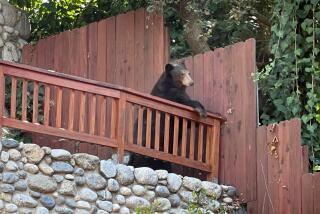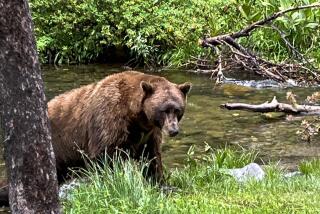Grouchy to Gleeful, Bears at Play...
- Share via
Susie June would never win “Miss Congeniality” among Alaskan brown bears.
In 10 years of observing Ursus arctos, biologist Robert Fagen has never encountered a more irritable member of the species, especially when she can’t get her fill of salmon.
Susie June would never be mistaken for young “C,” part of the same Pack Creek bear community on Alaska’s Admiralty Island. Her one-letter name could stand for charismatic, captivating or charming.
“She is flamboyant and sparkly, a real mover,” Fagen said. “At times she dances instead of walks, kicks up her heels and jumps, twists her head and shoulders sideways. We call her the Great Alaskan Goof--and yet what a genius she is.”
Scientists have never systematically studied bear personalities before, or assigned them scores based on specific traits.
But during three recent summers of salmon runs, Fagen’s team from the University of Alaska Fairbanks scrutinized seven coastal brown bears, the core of the Pack Creek group of about 30, for 16 hours a day.
Fagen, his wife, Johanna, and their field assistants set up a lookout 20 feet off the ground on a wooden platform built in a triangle of trees in the old-growth spruce-and-hemlock forest that borders the creek.
The seven bears, all readily recognizable, come back every season. Each is at least 7 years old, mature enough to be independent and capable of breeding. All are free-ranging, but have become accustomed to the presence of people, boats and aircraft on the island, a popular bear-viewing site.
The Fagens’ observations formed the final phase of their 10-year study of brown-bear play in the wild--the longest and most intricate field research ever conducted on animal play. Their work was partly supported by the National Geographic Society.
What makes each bear different from all the rest? “It’s not just their genes or their environment or their upbringing,” Fagen said. “Play--or the lack of it--could be much more important in shaping a bear’s personality. Each bear has the chance to do something unique and original when it plays. These novel experiences may hold a key to understanding why individual bears differ from one another. It may even explain why their intelligence can take so many different forms.”
What the animals are doing out there, Fagen said, “is certainly more than just survival.” Daily bear routine consists mainly of traveling about the community, carrying fish, eating and resting. The Fagens identified five distinct traits that give each of the Pack Creek bears individuality:
* Lively, curious and exuberant both in social situations and solitary activities such as moving about and fishing. “C” expresses her individuality in inventive, interactive play. She acts as if she’s glad to be a bear. The season of abundant salmon is a good time in her life, and she splashes about.
* Irascible, irritable, grumpy, hostile to other bears. Who else but Susie June? When she hasn’t caught many fish, Fagen said, this grouchy old female disciplines her cubs even when they do nothing to provoke her. Annoyed, she hits them with her paw or lunges at them.
“If another bear catches a fish, she’ll steal it just to make a point,” Fagen said. “And she doesn’t even play fair. Of all the bears, only Susie June seems to recognize that she can manipulate other bears’ inborn behavior. When she approaches a bear with a fish in its mouth, the other bear instinctively roars. When its mouth opens, the fish drops out and Susie June grabs it.”
* Confident with other bears. Cowboy, so called because of his bowlegs, centers his life around social and play relationships.
On a typical summer day, Fagen said, Cowboy plays about 15% of the time. He walks right up to other bears to make friends, confident that he’ll succeed. Rejection doesn’t deter him; Cowboy is “secure in himself. He has a different approach to life. He actually seems to like other bears and never takes offense at their behavior, an unusual attitude among this reclusive species. And this lack of hostility keeps him out of fish fights. He’s never the aggressor or the victim.”
* Expert at fishing. Blackie is quick, efficient and successful at catching salmon. And they’re seldom stolen from her.
* Active and alert. Blackie and “P,” another female, are the most restless and vigilant. “They are always monitoring everything around them,” Fagen said. “If they hear a sound or see something moving, up go their heads right away to check it out.”
Females Brownie and “M,” on the other hand, are slow-moving and mellow. “Brownie’s idea of fishing is to sleep next to the creek until the loud splashes of a fish moving upstream wake her,” Fagen said. “She catches the fish, eats it and goes back to sleep in the same spot.”
*
Brown bears of all ages play, but Fagen hasn’t seen Brownie play in years. Bears are one of a few animals for which play is a part of life even in adulthood. Fagen has observed bears tossing around salmon, sticks and logs. Some adult males wrestle peacefully with favorite partners, male or female.
“For long-lived animals like bears, play may have an additional effect, such as making them more efficient at fishing,” said zoologist John A. Byers of the University of Idaho.
“Individual differences in the social play of most mammals are the rule rather than the exception,” said biologist Marc Bekoff of the University of Colorado in Boulder, who studies canine play. “These differences are manifested in what animals do when they play and how long they play.”
Being a bear amounts to much more than having bear genes or living in bear environments, Fagen said. “Where did Susie June learn to steal fish so cunningly?”
More to Read
Sign up for Essential California
The most important California stories and recommendations in your inbox every morning.
You may occasionally receive promotional content from the Los Angeles Times.













